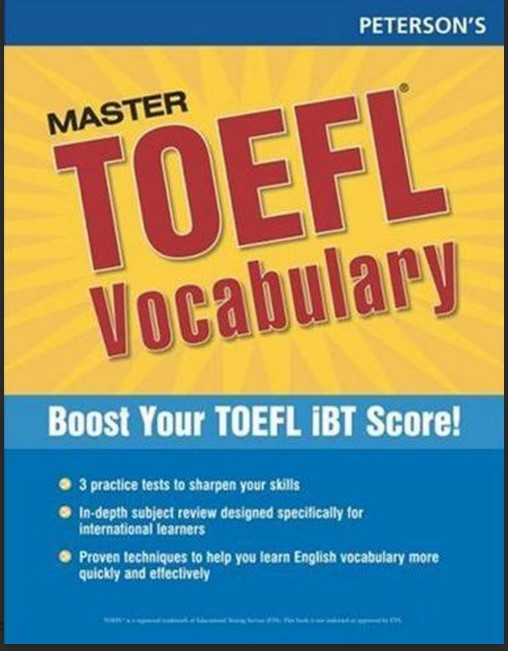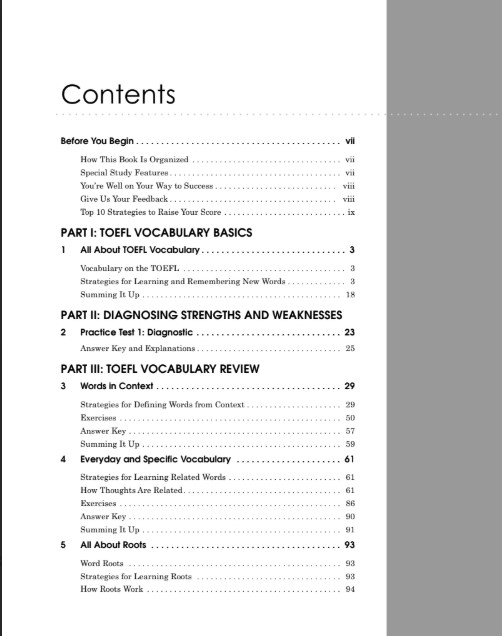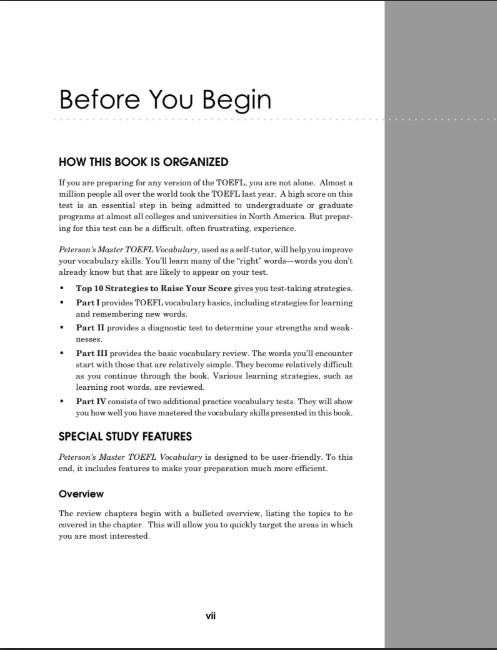


Image 1: Contents – Page 1
Contents
Before You Begin ……………………………………………………………………………………… vii
How This Book Is Organized ……………………………………………………………………….. vii
Special Study Features …………………………………………………………………………….. vii
You’re Well on Your Way to Success ………………………………………………………….. viii
Give Us Your Feedback …………………………………………………………………………… viii
Top 10 Strategies to Raise Your Score …………………………………………………………. ix
PART I: TOEFL VOCABULARY BASICS
1 All About TOEFL Vocabulary ………………………………………………………………….. 3
Vocabulary on the TOEFL ………………………………………………………………….. 3
Strategies for Learning and Remembering New Words ……………………………… 3
Summing It Up ………………………………………………………………………………….. 18
PART II: DIAGNOSING STRENGTHS AND WEAKNESSES
2 Practice Test 1: Diagnostic …………………………………………………………………… 23
Answer Key and Explanations ………………………………………………………….. 25
Image 2: Contents – Page 2
PART III: TOEFL VOCABULARY REVIEW
3 Words in Context ………………………………………………………………………………… 29
Strategies for Defining Words from Context ………………………………………….. 29
Exercises ………………………………………………………………………………………….. 50
Answer Key ……………………………………………………………………………………….. 57
Summing It Up ………………………………………………………………………………….. 59
4 Everyday and Specific Vocabulary ………………………………………………………… 61
Strategies for Learning Related Words …………………………………………………. 61
How Thoughts Are Related …………………………………………………………………. 61
Exercises ………………………………………………………………………………………….. 86
Answer Key ……………………………………………………………………………………….. 90
Summing It Up ………………………………………………………………………………….. 91
5 All About Roots …………………………………………………………………………………. 93
Word Roots ………………………………………………………………………………………. 93
Strategies for Learning Roots ……………………………………………………………… 93
How Roots Work ………………………………………………………………………………. 94
Learning Words with Greek Roots ………………………………………………………… 97
Learning Words with Latin Roots ……………………………………………………….. 101
Exercises ………………………………………………………………………………………… 110
Answer Key ……………………………………………………………………………………… 114
Summing It Up ………………………………………………………………………………… 115
6 All About Prefixes ……………………………………………………………………………. 117
Prefixes ………………………………………………………………………………………….. 117
Strategies for Learning Prefixes …………………………………………………………. 117
How Prefixes Work ………………………………………………………………………….. 118
Learning Words with Greek Prefixes …………………………………………………… 121
Learning Words with Latin Prefixes …………………………………………………… 127
Prefixes for Numbers ……………………………………………………………………….. 133
Anglo-Saxon Prefixes ……………………………………………………………………….. 133
Exercises ………………………………………………………………………………………… 135
Answer Key ……………………………………………………………………………………… 140
Summing It Up ………………………………………………………………………………… 142
7 All About Suffixes ……………………………………………………………………………. 143
Suffixes ………………………………………………………………………………………….. 143
Strategies for Learning Suffixes ………………………………………………………… 143
How Suffixes Work …………………………………………………………………………. 144
Suffixes That Describe State of Being ……………………………………………….. 148
Suffixes That Indicate Occupations …………………………………………………… 150
Suffixes That Show Resemblance ……………………………………………………. 152
Suffixes That Show Amount …………………………………………………………….. 155
Twelve Useful Suffixes …………………………………………………………………….. 155
Exercises ………………………………………………………………………………………… 159
Answer Key ……………………………………………………………………………………… 164
Summing It Up ………………………………………………………………………………… 166
PART IV: TWO PRACTICE TESTS
Practice Test 2 …………………………………………………………………………………….. 171
Answer Key and Explanations ………………………………………………………….. 176
Practice Test 3 …………………………………………………………………………………….. 181
Answer Key and Explanations ………………………………………………………….. 186
Image 3: TOP 10 STRATEGIES TO RAISE YOUR SCORE
TOP 10 STRATEGIES TO RAISE YOUR SCORE
- As with other sections of the TOEFL, be familiar with the directions and examples so you can begin work immediately.
- For each passage, begin by briefly looking over the questions (but not the answer choices). Try to keep these questions in mind during your reading.
- Scan passages to find and highlight the important facts and information.
- Read each passage at a comfortable speed.
- Answer the questions, referring to the passage when necessary.
- Eliminate answers that are clearly wrong or do not answer the question. If more than one option remains, guess.
- Mark difficult or time-consuming answers so that you can come back to them later if you have time.
- Timing is an important factor. Don’t spend more than 10 minutes on any one reading and the questions about it.
- Concentration is another important factor. The reading section is one of the longer sections of the test. Your practice and hard work will help you.
- Relax the night before the exam.
Image 4: All About TOEFL Vocabulary
All About TOEFL Vocabulary
OVERVIEW
- Vocabulary on the TOEFL
- Strategies for learning and remembering new words
- Summing it up
VOCABULARY ON THE TOEFL
TOEFL vocabulary questions ask you to identify the meanings of words and phrases that appear in the reading passages. The words and phrases that are tested are important to understanding the entire passage, and, for the most part, you will have to figure out their meanings. On the TOEFL iBT, however, if there are technical or unusual words in the passage, you will see the definition presented in a box.
STRATEGIES FOR LEARNING AND REMEMBERING NEW WORDS
Read
Reading is probably the single best way to improve your vocabulary. When you’re preparing for the TOEFL, read materials that contain the words that you are most likely to encounter.
Use a Dictionary and Thesaurus
If you’re serious about improving your testworthy vocabulary, you must have (and use!) a good dictionary. (A good thesaurus also helps a lot, but more on that later.) A dictionary is an alphabetical reference list of the words in the language.


